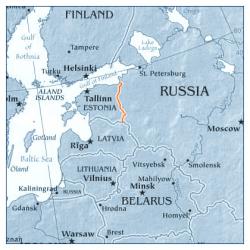
|







|

|


Geography, population profiles
The establishment of the Russian-Estonian border brought the rupture of the cultural, social and economic relations. Most of the border runs along Lake Peipsi, which forms a "natural" dividing line. The Russians on the Estonian side, mostly descendants of Russian Orthodox Old Believers, who emigrated here already in the mid 17th century, do not have much in common with their co-nationals in Russia. In the northeast of Estonia, mostly populated by post-war Russian-speaking immigrants, the city of Narva experienced a functional split after being cut off from the neighbouring Ivangorod in 1991. Along the southeast edge of the Estonian-Russian border, the Setus (10-15000 people, of whom less than 1000 live in Russia), who are culturally more similar to Estonians than Russians but also deeply influenced by Russian culture and Orthodox religion, consider Setumaa (or 'Setuland') an indivisible territorial unit and find the separation unacceptable. Ethnic structure is relatively homogenous on the Russian side, and there are no significant minorities in borderlands, except few hundreds Setus.
 - Regional Coordinator: Dr. Eiki Berg
Socio-economic and political situation of the area
The bordering Pskov region with its lower level of economic and human development compared to Estonia and even the rest of the Russian Federation, is still to realize its economic potential, in which its unique geographic location (i.e., bordering with Estonia, Latvia and Belorussia) might be the key factor. The social situation is especially difficult in the countryside and in small towns. Agriculture is almost abandoned; industry still suffers from the crisis of transition, and it forces people to work out personal "strategies of survival". The situation in the bordering Leningrad region is better - first of all, due to its relations with its administrative center St. Petersburg. The region is stretched from the east to the west, and small industry of the region's periphery still is in a difficult position, unemployment remains high, and the gap in the level of economic and human development between neighbouring Estonian and Russian areas is even higher than between these countries as a whole. The northeast of Estonia is one of the biggest industrial regions in Estonia, but its industry still suffers from the transition and its peripheral position. The southeast of Estonia is mostly agricultural with the highest unemployment rate and other socio-demographic problems resulting from its peripheral location.
Principal cross-border cooperation challenges
In this area cross-border cooperation has been seen as a mechanism for regional development. The Council for Cross-Border Cooperation, founded in 1996, was formed on the basis of 12 neighbouring districts of the Russian Federation, Latvia and Estonia, (see Figure 3), in order to improve the living conditions in this future euro-region and to simplify cross-border movement for local residents. In the northeast of Estonia and in Leningrad region of Russia conflicting interests prevail over cooperative initiatives. Firstly, the import of cheap foods and beverages from Russia by cross-border traders relieves the economic situation in Ivangord while Narva loses money and jobs. Similarly, the import of the cheap oil shale from Leningrad region is seen as a threat to the oil shale mining in the Northeast of Estonia. Secondly, the issue of the water level in the Narva reservoir is another source of disagreements. Thirdly, the establishment of a new port near Kingissepp, Russia, would decrease transit flows through Estonian ports. Fourthly, the differences between the two municipalities and their budgets (Narva budget is 28 times larger than that of Ivangorod) largely hinder new cooperative initiatives between Narva and Ivangorod Many regional officials in Estonia explain insufficient cross-border cooperation through the lack of rules established with a long-term perspective, favourable for cross-border cooperation. Their Russian counterparts, however, assume cross-border cooperation feasible only after achieving political and economic stability in the Russian Federation and its border regions, and at present unlikely to improve because of the abolishment of the simplified border-crossing regime in connection with the EU enlargement.
|

|